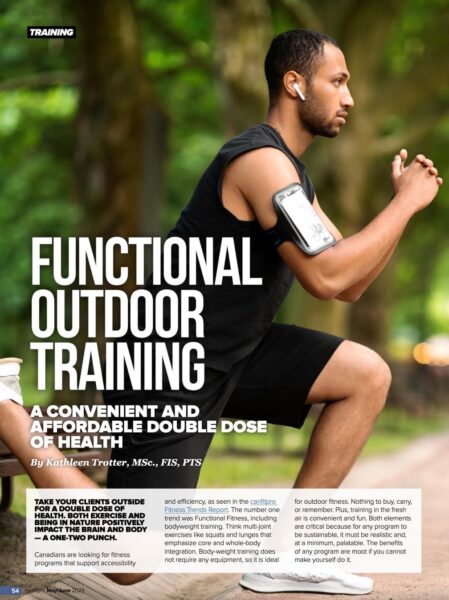 Take your clients outside for a double dose of health. Both exercise and being in nature positively impact the brain and body — a one-two punch.
Take your clients outside for a double dose of health. Both exercise and being in nature positively impact the brain and body — a one-two punch.
Try functional body-weight training. Think multi-joint exercises like squats and lunges that emphasize core and whole-body integration. Body-weight training doesn’t require any equipment, so it is ideal for outdoor fitness. Nothing to buy, carry, or remember. Plus, training in the fresh air is convenient and kinda fun. Both elements are critical because for any program to be sustainable, it must be realistic and, at a minimum, palatable. The benefits of any program are moot if you can’t make yourself do it.
Functional moves not only increase overall strength and fitness, they also simultaneously prepare the body to perform activities of daily living. By programing movement patterns that are required for daily life, you give your clients the strength and patterning to lift a heavy suitcase and/or do yard work with greater proficiency and ease, and lower risk of injury. The moves are literally “functional” … no wonder body-weight functional training was voted the #1 fitness trend in a recent canfitpro survey.
Turn the great outdoors into a gym
Amp up the walk
Nothing is more functional than walking. If accompanying your client to the park, don’t just saunter — try fartlek intervals. Fartlek is a Swedish term that means “speed play.” It is an unstructured form of interval training. Pick a landmark — like a stop sign or crosswalk. Speed up to get there. Once you hit your landmark, slow down and recover. Repeat until you reach the park, increasing your intensity as you go.
Make the park your gym
Consider a “fun” warm-up pyramid. Pick two functional exercises based on your client’s fitness level and injury profile. A low-impact version could be walking knee-ups and sit-to-stands on a bench. A more intense version could be high knee runs and squats. Start with 2 of each, then 4, then 6, then 8, then 10.
After the warm-up, use a park bench to do functional core and strength moves. For example, step-ups, V holds,, and/or push-ups.
- Step-ups:Place the entire right foot on the bench. Core engaged. Use the bum muscles of the leg on the bench to bring the left foot up to meet the right. Watch the hips. Don’t let the right hip jut out to the side. Step right leg down. Repeat, then switch sides.
- V holds: Sit bum on the bench, feet on the ground. Chest out. Hinge back slightly. Make sure your client engages their core and hinges from the hips, not through the lower back. Don’t let the shoulders round forward. Breathe. For added fun, add a twist side-to-side.
- Push-ups: Hands on the bench. Toes on the ground. Bend the elbows and lower the chest toward the bench. Exhale to push back up. For an extra challenge, after each push-up, try jumping the feet out like a horizontal jumping jack.
Or create a circuit. Program a few functional moves followed by a run around the perimeter of the park or a cardio move like burpees.
If you can find an outdoor playground, try pull-ups and/or an incline plank with forearms on a swing.
Combine hill runs or stairs with strength work
Mix in stairs or hill running with a functional strength move like squats or hinges. What is more functional than squats and stairs? Everyone needs to go to the bathroom and climb stairs.
Examples:
Run the stairs 5 times. Do 2 squats. Repeat the same number of stairs. Each round, increase the number of squats by 2 until you get to 12.
Find a hill. Pyramid the hill and a functional strength move. Run the hill 2 times. Do 2 hinge lunges. Each time, increase the number of hill runs by 2 and the number of hinge lunges by 2 until you get to 10 hill runs and 12 hinge lunges.
The hinge lunge integrates two key functional moves: the lunge and the deadlift. Instruct client to start in a lunge. Right leg in front. Feet forward like train tracks. Bend knees; back knee moves towards the floor. Hold. Hinge torso forward like a deadlift. Chest out. Use the right bum and core muscles to bring the torso back to vertical. Straighten legs to stand.
Final thought
Give homework. Set a daily steps goal, a minimum water and vegetable target, and/or write down a functional outdoor program clients can do on their own. If they have a dog suggest they do fartlek intervals with the pooch and/or at the dog park do functional moves such as squats or lunges while their dog retrieves a ball. Ultimately, you want clients to be independent; give them the tools to make healthier choices throughout their life, not just during sessions.












